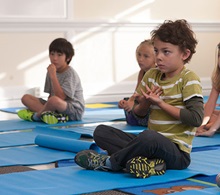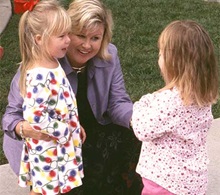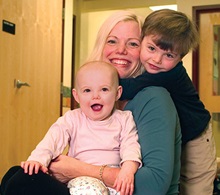 Few topics are as sensitive to talk about with children as weight and body image. How do we as parents contribute to positive body images in our children and teach healthy eating practices without making anyone feel guilty or bad? That can be a tall order. We know we need to start young and set the stage for healthy lifetime habits early. Before we even talk about the topic, however, we can model positive practices.
Few topics are as sensitive to talk about with children as weight and body image. How do we as parents contribute to positive body images in our children and teach healthy eating practices without making anyone feel guilty or bad? That can be a tall order. We know we need to start young and set the stage for healthy lifetime habits early. Before we even talk about the topic, however, we can model positive practices.
Children Learn Healthy Eating Habits from Modeling
If we have healthy eating habits, chances are our children will too. Or if we are selective eaters and avoid fruits and veggies, they will likely follow our lead. We can model by building family nutrition and fitness into our family’s day on a regular basis. Can we share meals together – lunch or dinner – at least four days per week? Are there ways we can exercise together, for example, swimming, walking or bike rides to promote healthy exercise habits?
While modeling healthy eating habits, be careful about the messages you send to children about food and eating. Try to avoid the practice of requiring children to eat everything on their plate at meal time which may have been required of us as children. There are different opinions on this, but some health educators encourage children to try one bite of everything, never pushing or forcing. Others advocate for offering children a favorite food and a new food together so they will have at least one healthy food option that they like.
Steer clear of labeling different foods as “bad” or “unhealthy”. If you label a food unhealthy, it is confusing to children when they then see a beloved caregiver or friend eating that food. You can say that healthy eating refers to the whole of what we eat, and not one individual food or foods which are “bad” for you. The Partnership for a Healthier America is embarking on a campaign to encourage everyone to eat more fruits and vegetables. Taking the approach of encouraging healthier snacks may be more productive than singling out “bad” foods.
KidsHealth.org offers “Go, Slow, and Whoa!” as another approach to healthy eating:
- “Go” foods are the healthiest options for kids and can be eaten almost anytime
- “Slow” foods are those you can eat sometimes but not every day
- “Whoa” foods should make you think, “Wait, should my child eat that?” These are the least nutritious and should only be eaten occasionally.
Healthy Eating Habits for Young Children
- Infants: With infants, we pay attention to their cues, and stop feeding them when they indicate they are finished by turning away or refusing the breast, bottle or spoon. Be careful what food choices you make for your baby. Solids are not recommended to be served until at least 4 months of age or often later. And even infants can develop preferences for sweets over other foods, particularly if their first solid foods are desserts or fruits.
- Toddlers and Preschoolers: With toddler and preschool children, provide healthy snacks and beverages such as water. Eating slowly together as a family is a good practice. Never require children to eat when they are not hungry. And try not to use food as a reward or punishment. If you notice that your child is developing eating issues, they should be discussed with your pediatrician right away.
Talking to Preteens and Teens about Positive Body Image and Healthy Habits
From their earliest years, children are immersed in images and talk of the “ideal” body, typically slim, light skin tone and well-proportioned. And yet we all know genetics gives each of us a unique body type, few of which fall into the “ideal” category. And even those with “ideal” body types often feel pressure to maintain their “ideal” body.
With tweens and teens, subtle and not so subtle messages about weight and body type have an impact. These body images come from people, television, magazines, social media, etc. If your son or daughter opens up the subject, use it as an opportunity to communicate that very few people look like models; models also feel stress about their bodies; and being really skinny isn’t a good thing.
If your child says “I’m too fat” rather than jumping to “No, you’re not” right away, ask “What makes you think that?” to try to keep the conversation open and keep your child talking about this issue. It’s important to know how to communicate with your teen. Spend time listening to him or her. Express your feelings about the topic, but rather than negating your child’s feelings, try saying, “Here’s what I think. . . ” so it feels more like your personal thoughts than a judgment on your child. At the same time, if you ever suspect an eating disorder, talk right away to your pediatrician to find resources.
Talking about weight, body image and health can be sensitive, but it is also very worthwhile to keep the topic on the table and encourage children to talk about what they think and feel. Remember that feelings about this body image start early so be thoughtful about the impact of your words and actions in your child’s life.
 One annual tradition in families around the world is to set goals, or resolutions, on New Year’s Eve. If you and your family celebrate this tradition it is a great opportunity to start to talk to your children about how to set goal that are going to help them to achieve their personal objectives in life.
One annual tradition in families around the world is to set goals, or resolutions, on New Year’s Eve. If you and your family celebrate this tradition it is a great opportunity to start to talk to your children about how to set goal that are going to help them to achieve their personal objectives in life.
 It’s no doubt that children are one of life’s miracles but as our offspring we sometimes tend to forget that while they may be all that is good in us, they are not our clones and are certainly not little adults. They are incapable of handling things in the same way that we are – which means they are unable to manage stress like we can. Not to mention, something that we would easily overlook would be a severe stressor to our kids – for example, showing up at school and finding desks rearranged differently than they have been all year or a substitute teacher instead of their regular teacher.
It’s no doubt that children are one of life’s miracles but as our offspring we sometimes tend to forget that while they may be all that is good in us, they are not our clones and are certainly not little adults. They are incapable of handling things in the same way that we are – which means they are unable to manage stress like we can. Not to mention, something that we would easily overlook would be a severe stressor to our kids – for example, showing up at school and finding desks rearranged differently than they have been all year or a substitute teacher instead of their regular teacher. We all have had at least one role model in our lives. Role models are important to our psychological well-being because they help us guide us through certain decision making processes that can ultimately affect the outcome of our lives. Children often have many choices when it comes to choosing role models – most often their first role models are parents followed by other adults and relatives, such as teachers.
We all have had at least one role model in our lives. Role models are important to our psychological well-being because they help us guide us through certain decision making processes that can ultimately affect the outcome of our lives. Children often have many choices when it comes to choosing role models – most often their first role models are parents followed by other adults and relatives, such as teachers. Whether you have a shy child or outgoing one, it can be challenging for children to make new friends and navigate social situations on their own. Though it’s not a good idea to manage every aspect of your children’s friendships or even bribe their peers to play with them, parents can provide opportunities and gentle coaching towards helping children make friends.
Whether you have a shy child or outgoing one, it can be challenging for children to make new friends and navigate social situations on their own. Though it’s not a good idea to manage every aspect of your children’s friendships or even bribe their peers to play with them, parents can provide opportunities and gentle coaching towards helping children make friends. Bringing home a new baby is an exciting and magical event for any family. Preparing your home in advance for the big day helps parents to proactively provide built in safety for the new addition to the family.
Bringing home a new baby is an exciting and magical event for any family. Preparing your home in advance for the big day helps parents to proactively provide built in safety for the new addition to the family. It can be a difficult task teaching children that it is better to give than to receive – after all who doesn’t like to receive a gift right? However, by teaching your children this valuable lesson is one of the most rewarding things you can give them.
It can be a difficult task teaching children that it is better to give than to receive – after all who doesn’t like to receive a gift right? However, by teaching your children this valuable lesson is one of the most rewarding things you can give them. Few topics are as sensitive to talk about with children as weight and body image. How do we as parents contribute to positive body images in our children and teach healthy eating practices without making anyone feel guilty or bad? That can be a tall order. We know we need to start young and set the stage for healthy lifetime habits early. Before we even talk about the topic, however, we can model positive practices.
Few topics are as sensitive to talk about with children as weight and body image. How do we as parents contribute to positive body images in our children and teach healthy eating practices without making anyone feel guilty or bad? That can be a tall order. We know we need to start young and set the stage for healthy lifetime habits early. Before we even talk about the topic, however, we can model positive practices. We live in a constantly changing world. The pace of change is the most rapid that it has ever been. New products and processes are continually available and the rate at which we are exposed to new information is continually increasing. This can be overwhelming at times. Sometimes we are able to shelter our children from so much change, but often not. If it is overwhelming to us, how does it feel to children? And that is just “normal” everyday change. What about the big unexpected changes?
We live in a constantly changing world. The pace of change is the most rapid that it has ever been. New products and processes are continually available and the rate at which we are exposed to new information is continually increasing. This can be overwhelming at times. Sometimes we are able to shelter our children from so much change, but often not. If it is overwhelming to us, how does it feel to children? And that is just “normal” everyday change. What about the big unexpected changes? In the summertime, it’s second-nature to apply tons of sunscreen on our children to protect their skin from the harmful effects of the sun. But many times, as much attention as we give to their skin, we often overlook another area that can be damaged by the sun – their eyes.
In the summertime, it’s second-nature to apply tons of sunscreen on our children to protect their skin from the harmful effects of the sun. But many times, as much attention as we give to their skin, we often overlook another area that can be damaged by the sun – their eyes. When is that baby going back to the hospital?” asked the preschooler to her mother holding her new baby brother.
When is that baby going back to the hospital?” asked the preschooler to her mother holding her new baby brother.